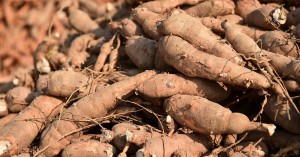
JUNE 25 — The Department of Agriculture (DA), through the Bureau of Plant Industry (BPI), has intensified measures to control the spread of witches’ broom disease, which could endanger the country’s growing cassava industry if not proactively addressed.
A bacteria-like organism called phytoplasma causes the witches’ broom disease.[1] The disease reduces cassava root starch content, hence reducing yield value and farmers’ income.
Symptoms not noticeable
The BPI said that the witches’ broom disease is systemic and asymptomatic, making efforts in controlling its spread more challenging than with other diseases.[2]
Its symptoms may not be immediately noticeable as the infection starts in the innermost bark of the plant. It is only when the clumping of leaves, as well as discoloration, are observed can farmers conclude that their plants are infected.
The danger of this the disease’s asymptomatic characteristic is that infected planting materials may be unknowingly sourced from infected plantations and will be transferred to other plantations, spreading the disease to a wider geographic cover. The BPI added that even using contaminated farm implements may cause the spread of the disease.
The bureau then has warned cassava farmers that visual observation cannot guarantee the cleanliness of planting materials.
Responses
BPI Director Paz Benavidez II has created a technical working group to focus on the control and management of the disease. A plant quarantine memorandum banning the movement of infected cassava from Bukidnon has also been issued by the agency.
To implement long-term solutions, the BPI is seeking funding support for the agency to work on the adoption of protocol used by the United States Department of Agriculture on the detection of the cassava witches’ broom pathogen. When this protocol is already in place, the BPI will conduct disease indexing, a process that includes thorough screening of cassava planting materials. Through this system, only clean plants will be allowed to be distributed and grown.[3]
“At least four research centers where disease detection and indexing are conducted will become the source disease-free planting materials for cassava farmers in the country,” Director Benavidez said.
While the protocols are not yet ready, the BPI is now crafting with experts interim measures on how farmers should handle cassava growing. The bureau’s crop pest management division, in coordination with DA regional field offices, plans to conduct farmer field school activities on the disease, which will provide participatory and experiential learning venue for farmers on the witches’ broom disease.
The BPI is also conducting an experiment on heat treatment to test if this technology could help in combating the disease.[4]
Infection of other plants
The BPI has assured farmers that infection of other plants such as corn and vegetables is not possible.
A BPI scientist explained that other crops host their own specific kind of phytoplasma such that the cassava witches’ broom phytoplasma cannot be hosted by other plants other than cassava.
According to Dr. Erlinda Vasquez of Philippine Root Crop Research and Training Center, the country has yet to determine the exact number of hectares affected as the DA regional field offices are still conducting surveys. But she added that there are already thousand hectares of cassava plantations affected.
Agriculture Secretary Proceso Alcala has urged farmers to be vigilant and immediately report symptoms of the disease to their local agricultural officers. He has also advised farmers not to source out planting materials from previously infected areas and practice diversified cropping to have alternative source of income and food in case of witches’ broom disease outbreak.
Things to remember:
[1] Phytoplasma interferes in plant development and according to the BPI, infected plants exhibit short nodes with dense clumping of stunted leaves, resembling a witch’s broom.
[2] A BPI scientist explained that when a disease is systemic, it does not only affect a single part or some parts of a plant but the whole plant system.
[3] The seed quality control, and the crop research and production support offices of the BPI are also collecting planting materials for the BPI national research centers to grow. These will later be subjected to detection and indexing protocols.
[4] Developing a resistant variety, on the other hand, would not an option for now as no resistant variety for any kind of phytoplasma has been developed yet.








